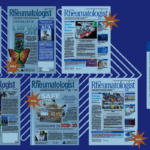 One of the great joys of rheumatology is that it prioritizes systems-based thinking. Whether integrating data from radiographic imaging or piecing together a puzzling case of autoimmunity, rheumatologists are tasked with understanding how systems fundamentally work. In fact, this emphasis on systems-based thinking is often what draws and keeps the best and smartest physicians within our field. Our reluctance to own an organ has led us to gain a wide-ranging perspective on disease, illness and health.
One of the great joys of rheumatology is that it prioritizes systems-based thinking. Whether integrating data from radiographic imaging or piecing together a puzzling case of autoimmunity, rheumatologists are tasked with understanding how systems fundamentally work. In fact, this emphasis on systems-based thinking is often what draws and keeps the best and smartest physicians within our field. Our reluctance to own an organ has led us to gain a wide-ranging perspective on disease, illness and health.
This is even more true today than in the time of our rheumatologic predecessors. Advances in all sorts of diagnostic and treatment modalities have honed our systems-based thinking and have allowed us to improve the lives of many battling autoimmune and musculoskeletal diseases. Our predecessors could only have imagined biologic agents that prevent progressive pain and deformity. Even so, there is an even greater opportunity for us to use systems-based thinking. We can use our perspectives and our expertise to go beyond physiological systems of the human body into larger interpersonal systems that make up our world. As rheumatologists, we can play an enormous role in redesigning our healthcare systems via legislative and regulatory advocacy. Why should we do this and how? Let’s rheuminate!
This Advocate’s Story
My advocacy story starts in the distant past of 2016. Many things happened in 2016; perhaps the most momentous for me was an email inviting me to apply for Advocacy 101. Launched just one year earlier in 2015, the program introduced fellows and program directors to the world of advocacy. After some thought, I sent a completed application and was accepted. I didn’t know what exactly to expect, apart from a few lectures about governance and an opportunity to go to Capitol Hill.
It ended up being an incredibly eye-opening experience. While I was familiar with how the government works from a theoretical perspective, until that time, I did not quite understand the practical inner workings of how policy gets made. I had imbibed from my social circles and from the media (including social media) that policy is rather static and doesn’t change that much unless powerful leaders make the change. I couldn’t have been more wrong; it is the everyday actions of citizens that propel policy changes and animate the government’s actions. In fact, it was so profoundly life-changing that, eight years later, I routinely engage in advocacy activities both in Washington, D.C., and beyond. That event provided me with the insight to see a larger system that patients and clinicians are all tied to. Although I would love to write at length about this structure, there are only so many pages in The Rheumatologist, so I’ll go over just four aspects of this sprawling system.


